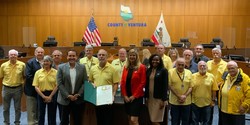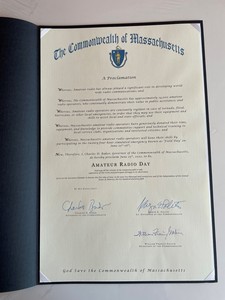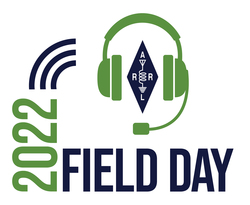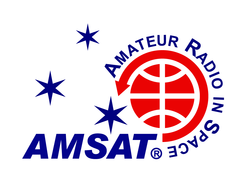 June 16, 2022 John E. Ross, KD8IDJ, Editor
| ||||||
Proclamations Honor Amateur Radio in Run Up to ARRL Field Day In the run up to 2022 ARRL Field Day, which takes place June 25 - 26, many radio clubs and groups have pursued government proclamations to garner greater attention and public awareness for ham radio and their efforts.
In Florida, the Jupiter Tequesta Repeater Group (JTRG), an ARRL Affiliated Club, recorded a radio interview with iHeart Talk Show Host Deb Knepp for Field Day 2022. JTRG President Bert Moreschi II, AG4BV, reported that the program will be aired for the next two Sundays (June 19 and 26), in the morning, on the show Palm Beach Perspective. The program is already available as a podcast and will air on all iHeart radio stations in the South Florida area. On Tuesday, June 21, a 10-minute interview discussing ARRL Field Day will air between 5 and 9 AM EDT on WJNO's morning show, The Morning Rush, with Joel Malkin and Brian Mudd.
ARRL Contest Program Manager Paul Bourque, N1SFE, reminds groups planning their ARRL Field Day participation that they can earn bonus points for obtaining media publicity promoting their activity and general awareness of amateur radio. Bonus points can also be earned for a Field Day site visit by an elected government official, and for setting up a public information table to help promote ham radio to visitors. For more information about ARRL Field Day, visit www.arrl.org/field-day. AMSAT Announces Youth Initiative at Hamvention® AMSAT formally introduced plans for its Youth Initiative during a forum at the 2022 Dayton Hamvention® on Saturday, May 21. After 2 years of planning, the program will now proceed in a series of phased releases. AMSAT Vice President of Development Frank Karnauskas, N1UW, outlined the highlights of the program.
"The Youth Initiative takes a radically different approach to introducing youth to amateur radio and satellites," he said. "It approaches youth in terms that are already central to their everyday lives, whether it be climate change, pollution control, preservation of natural resources, meteorology, or a career in broadcasting or transportation industries or in the military, the use of satellites is pervasive in virtually everything we do." He added, "Our message to youth is 'Satellites in Space Help Us Live Better Lives Here on Earth.' Once we have gained the youth's interests, we can engage them in experiences and exercises that then use amateur satellites and amateur radio as their laboratory or classroom." Karnauskas also said that because this is a community-based program, the experiences will be available directly to youth, their parents, and all youth organizations. The program will be promoted through AMSAT trademarks (KidzSat® for grades 5 - 7 and BuzzSat® for grades 8 - 12) and all content is openly and freely available. Karnauskas went on to summarize key components of the Youth Initiative that serve as the engagement points with youth, including:
Karnauskas concluded, "The Youth Initiative is not only the right thing to do, but also the essential thing. By focusing on what our Articles of Incorporation direct us to do, [such as] advancing scientific and educational skills and knowledge, we appeal to a broader segment of society that can provide the financial support and critical resources that AMSAT needs to flourish." For more information about AMSAT, visit www.amsat.org. -- Thanks to AMSAT Reverse Beacon Network Launches Updated Website At 0500 UTC (1 AM EDT) on Thursday, June 16, the Reverse Beacon Network (RBN) launched their updated website (www.reversebeacon.net). The intent of the revised website was to replace the original and beta websites and to include a Secure Sockets Layer (SSL) to enhance security for users of the site. The RBN is a network of stations that listen to the bands and report what stations they hear, including when and how well. The website's database of past spots allows operators to instantly find what stations (from any given country or zone) have been heard, at what times, and on what frequencies. Operators can also see when they have been spotted, who spotted them, and how loud the contact was. There is an option to compare your signal with those of friends and competitors, in near real time, or look at historical data of previous transmissions. If you wonder how your signal compared to others' during a previous contest, the website's Signal Comparison Tool will provide real, quantitative data. For an instant report, query what stations you want to compare, based on signals heard by a given reverse beacon on a certain band at a certain time. In 2009, Pete Smith, N4ZR, and Felipe Ceglia, CT7ANO, worked to get the first version of RBN online. The work of Mark Glenn, K7MJG, on the website and Dave Pascoe, KM3T, on connecting the servers, contributed to RBN as a resource for listening and tracking signals. The new version is the first major upgrade for the site. A guide to the website's new features is available on the beta site, as well as on the new site under the 'about' tab. -- Thanks to Pete Smith, N4ZR
ARRL Podcasts Schedule
The latest edition (Episode 62) of the ARRL Eclectic Tech podcast features an interview with David Kazdan, AD8Y, about the work he and the members Case Western Reserve University Amateur Radio Club are doing to create new applications for Coherent CW.
The On the Air and Eclectic Tech podcasts are sponsored by Icom. Both podcasts are available on iTunes (iOS) and Stitcher (Android), as well as on Blubrry -- On the Air | Eclectic Tech. Amateur Radio in the News ARRL Public Information Officers, Coordinators, and many other member-volunteers help keep amateur radio and ARRL in the news. "ROARS club to demonstrate emergency communications at Amateur Radio Field Day" / Ramona Sentinel (California), June 15, 2022 "Sussex County Amateur Radio Club to participate in national event" / The Advertiser - News South (New Jersey), June 13, 2022 -- Sussex County ARC is an ARRL Affiliated Club. Share any amateur radio media hits you spot with us. Announcements DX Engineering has announced that it has added Penta Laboratories RF vacuum tubes to its product line. "In the ham radio community, special RF power vacuum tubes are essential replacements for current model amplifiers. They are also used to revive legacy amplifiers, and some technically savvy operators build vintage-style homebrew equipment and other devices using vacuum tubes," included the DX Engineering announcement. Penta Laboratories describes that it "was founded in 1951, and quickly achieved industry-wide recognition for the development of the beam-power Pentode vacuum tube." The company stocks thousands of tubes for a range of disciplines, including vacuum tubes designed for ham radio and other radio frequency applications. Penta Laboratories' states that their tubes are burned in for a minimum of 48 hours, dissipating full power with filament plate, and support screen voltages that are normally used in amplifier applications.
In Brief... On June 5, 2022, the Central Ohio Radio Club (CORC) celebrated the 50 years of the installation and activation of their main repeater on 146.76 MHz. The official celebration was delayed 2 years because of COVID. On Friday, June 19, 1970, club members John Hull, W8RRJ, and Gary Hedden, WA8JFP, completed the installation with an omnidirectional antenna for the transmitter and 2-meter beam for the receiver. CORC was first licensed in 1954 and has been an ARRL Affiliated Club since June 29, 2011.
The K7RA Solar Update Tad Cook, K7RA, Seattle, Washington, reports: Solar activity increased this week, which we were happy to see, with average daily sunspot number rising from 44.4 last week to 74.3 during this reporting week, June 9 - 15, 2022. Sunspot numbers rose all week, starting at 17 on Thursday, June 9, to 149 on Wednesday, June 15.
Average daily 10.7-centimeter solar flux increased from 99.4 to 123.9. Solar flux peaked at 145.5 on Tuesday, June 14. The solar flux outlook appears promising for the near term. The June 15, 2022, forecast from the USAF Space Weather Squadron shows solar flux at 140 on June 16; 138 on June 17 - 19; 136, 134, 132, and 120 on June 20 - 23; 100 on June 24 through July 5; 105, 110, and 115 on July 6 - 8; 120 on July 9 - 11; 125 on July 12 - 16, and 120 on July 17 - 18. Predicted planetary A index, a measure of geomagnetic stability, is 14 on June 16; 8 on June 17 - 18; 5 on June 19 - 22; 12, 18, 10, and 8 on June 23 - 26; 5 on June 27 through July 7; 8 on July 8 - 10; 5, 8, 12, 10, and 8 on July 11 - 15, and 5 on July 16 - 19. In Friday's bulletin, look for comments and reports from our readers. Sunspot numbers for June 9 - 15 were 17, 33, 41, 63, 96, 121, and 149, with a mean of 74.3. The 10.7-centimeter flux was 106.4, 110.5, 112.1, 121.3, 131.5, 145.5, and 140, with a mean of 123.9. Estimated planetary A indices were 5, 5, 8, 9, 13, 8, and 20, with a mean of 9.7. Middle latitude A index was 6, 6, 10, 12, 14, 10, and 18, with a mean of 10.9. A comprehensive K7RA Solar Update is posted Fridays on the ARRL website. For more information concerning radio propagation, visit the ARRL Technical Information Service, read "What the Numbers Mean...," and check out the Propagation Page of Carl Luetzelschwab, K9LA. A propagation bulletin archive is available. For customizable propagation charts, visit the VOACAP Online for Ham Radio website. Share your reports and observations. A weekly, full report is posted on ARRL News. Just Ahead in Radiosport
Visit the ARRL Contest Calendar for more events and information. Upcoming Section, State, and Division Conventions
Search the ARRL Hamfest and Convention Database to find events in your area. Have News for ARRL? Submissions for the ARRL Letter and ARRL News can be sent to [email protected]. -- John E. Ross, KD8IDJ, ARRL News Editor
ARRL -- Your One-Stop Resource for
Subscribe to...
Free of charge to ARRL members...
| ||||||
 In Ventura County, California, the Board of Supervisors has passed a resolution proclaiming June 2022 "Amateur Radio Month" in honor of the more than 3,800 amateur radio operators in the county. The recognition was made possible through the efforts of Amateur Radio Emergency Service® (ARES®) District Emergency Coordinator for Ventura County Rob Hanson, W6RH, with support from the ARRL
In Ventura County, California, the Board of Supervisors has passed a resolution proclaiming June 2022 "Amateur Radio Month" in honor of the more than 3,800 amateur radio operators in the county. The recognition was made possible through the efforts of Amateur Radio Emergency Service® (ARES®) District Emergency Coordinator for Ventura County Rob Hanson, W6RH, with support from the ARRL  In Massachusetts, Governor Charles D. Baker has declared June 25 to be "Amateur Radio Day." The proclamation recognizes the Commonwealth's radio amateurs for their service to the public in times of hurricanes, tornados, floods, and other emergencies. The proclamation was obtained by Massachusetts State Government Liaison Hank McCarl, W4RIG, of Gloucester. McCarl, an ARRL Life Member, contacted the office of State Senate Minority Leader Bruce Tarr, N1UIU, to arrange for the issuance of the proclamation. "Copies of the proclamation will be distributed to both Eastern and Western Massachusetts Section Managers, so that they may display the documents as they tour ARRL Field Day sites in their respective Sections," said ARRL
In Massachusetts, Governor Charles D. Baker has declared June 25 to be "Amateur Radio Day." The proclamation recognizes the Commonwealth's radio amateurs for their service to the public in times of hurricanes, tornados, floods, and other emergencies. The proclamation was obtained by Massachusetts State Government Liaison Hank McCarl, W4RIG, of Gloucester. McCarl, an ARRL Life Member, contacted the office of State Senate Minority Leader Bruce Tarr, N1UIU, to arrange for the issuance of the proclamation. "Copies of the proclamation will be distributed to both Eastern and Western Massachusetts Section Managers, so that they may display the documents as they tour ARRL Field Day sites in their respective Sections," said ARRL 

.jpg) The latest episode of the ARRL
The latest episode of the ARRL .jpg)

-Blue.jpg)








